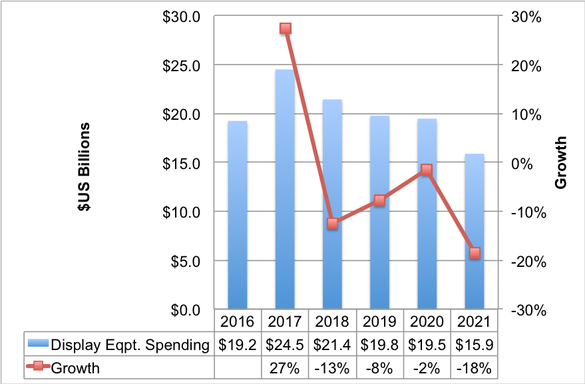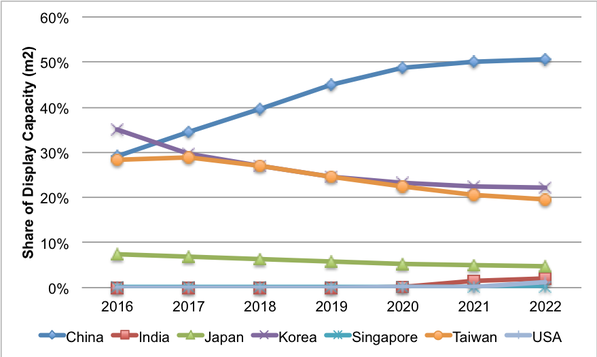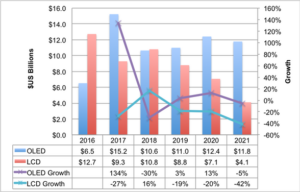From 2017 to 2022, display suppliers are predicted to spend $109 billion, down from the $116 billion predicted last quarter, to meet the demand for larger and higher-resolution TVs and thinner, lighter and flexible mobile displays, according to DSCC. While 2017 was a record year, 2018 is expected to be a down year outside of China, with total spending down 13%—DSCC’s previously forecast a 9% decline.
 Source: DSCC’s Quarterly Display Capex and Equipment Service
Source: DSCC’s Quarterly Display Capex and Equipment Service
Korea’s share of spending is expected to fall from 42% in 2017 to just 12% in 2018, a 75% decline. However, in China, equipment spending is expected to rise 49% in 2018 and account for an 88% share. 2018’s equipment spending of $21 billion is expected to be evenly split between LCD and OLED fabs, with LCD spending rising 16% and OLED spending falling 30%. However, from 2019, OLED spending and growth is expected to outpace LCD spending.
 Source: DSCC’s Quarterly Display Capex and Equipment Service
Source: DSCC’s Quarterly Display Capex and Equipment Service
DSCC CEO Ross Young said:
“Despite weakness in current mobile OLED fab utilisation, we continue to see healthy levels of OLED and LCD fab spending in China with awards and POs updated weekly. China is clearly driving display spending and will account for an 88% share in 2018, consisting of 83% of OLED equipment spending and 93% of LCD equipment spending, at a total of $18.9 billion. China’s capacity growth is expected to rise at a 17% CAGR from 2017 through 2022, with no other region growing over 3%. As a result, China’s share of display capacity is expected to rise from 35% to 50%. By 2020, China will have more than double the share of Korea or Taiwan”.
Source: DSCC’s Quarterly Display Capex and Equipment Service
In 2019, DSCC forecasts equipment spending of $21 billion, down 8% from 2018, which is 20% below its prior forecast due to continued delays at Samsung. In 2019, China will account for 71% of equipment spending versus Korea at 19%. In 2020, we expect Samsung and LG to add significant capacity, with $19.5 billion in equipment spending, which is 5% ahead of previous expectations, but down 2% year-on-year. China will still lead in equipment spending at 59% versus Korea at 32%.
Bookings are expected to fall 23% in 2018 due to fab delays but positive bookings growth is expected in 2019 and 2020. As a result, the display book to bill was 0.94 in 2017 and is expected to fall to 0.83 in 2018, before rising to 0.96 in 2019 and 1.01 in 2020. While LCD and OLED spending is expected to split the market 50/50 in 2018, OLED is forecasted to gain share each year thereafter, reaching ~75% in 2021 and 2022 as OLED demand continues to outpace that of LCD. From 2018 to 2021, OLED equipment spending should hold a 60/40 advantage over LCD.
 Source: DSCC’s Quarterly Display Capex and Equipment Service
Source: DSCC’s Quarterly Display Capex and Equipment Service
From 2018 to 2021, DSCC expects BOE to account for 25% of equipment spending at $19.2 billion, with LG Display at $13 billion and a 17% share, and China Star at $11 billion and a 15% share. 13 different display companies are expected to spend over $1 billion on equipment over these four years, 9 of them in China. BOE should reach number one in display capacity in 2019, with a 17.5% share. While it will lead the LCD market from 2019, it will reach number three in OLED and number two in mobile OLED from 2020.
Foxconn is #1
If all of Foxconn’s display companies are considered a single entity, then Foxconn is the number-one supplier in 2017 and 2018 on a capacity basis before being overtaken by BOE in 2019. From 2018 to 2021, exposure equipment is expected to be the number-one category, with a 10% share, followed by VTE at 8.6% and CVD with 5%

